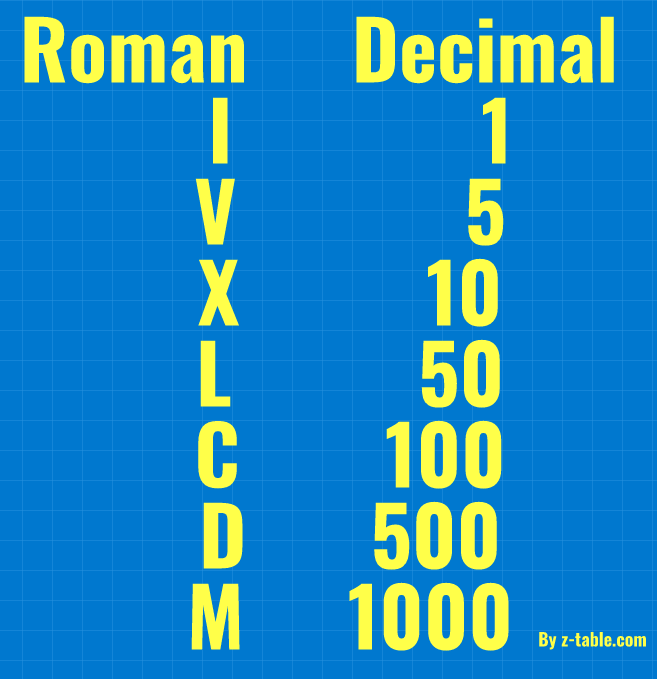4 in Roman Numerals
The Arabic numeral 4 is central in our counting system, known for its simplicity and significance in various realms. Represented as IV in the Roman numeral system, 4 embodies both the straightforwardness of the Arabic numerals and the intricacy of the Romans' subtractive principle. In this discourse, we'll place the spotlight on the number 4 and delve into its Roman counterpart, IV.
Sometimes conversion of Roman Numerals can be a daunting task, especially for larger numbers. You can always use a Roman numerals converter if you need to quickly convert Roman numerals to decimal numbers .
Sometimes conversion of Roman Numerals can be a daunting task, especially for larger numbers. You can always use a Roman numerals converter if you need to quickly convert Roman numerals to decimal numbers .
The Significance of 4
In Arabic numerals, the number 4 holds a foundational role. Positioned after 3 and before 5, it's a prime number and is integral in foundational arithmetic, everyday life activities, and symbolisms. When this number transitions to the Roman numeral system, it is portrayed uniquely as IV.
| Roman Numeral | Value |
|---|---|
| I | 1 |
| V | 5 |
| X | 10 |
| L | 50 |
| C | 100 |
| D | 500 |
| M | 1000 |
Representation of 4 as IV
The Roman numeral IV is an emblem of the subtractive principle in action. Here, the numeral I (representing 1) stands before V (indicating 5). This order suggests subtraction, leading us to the interpretation: 5 minus 1, yielding 4.
Key Considerations of Number 4 and IV
- Addition in the Roman Paradigm: When a larger numeral follows a smaller numeral, their values are added. For example, VI translates to 6, derived from 5 + 1.
- Embracing the Subtractive Principle: IV's unique configuration stems from subtraction, wherein a smaller numeral preceding a larger one indicates that the smaller value is subtracted from the larger. This positioning gives IV its value of 4.
- Repetitive Roman Elements: While numerals can be reiterated for emphasis in the Roman system, such repetition is typically limited to three consecutive occurrences.
- Repetition Constraints: The Roman numeral system favors conciseness, which is why 4 is articulated as IV instead of the lengthier IIII.
Adjacent Numerals to 4
Gaining a broader perspective on 4 involves examining its neighboring numbers:
- III, which signifies 3.
- IV, denoting 4.
- V, representing 5.
Insights into the Arabic Numeral 4
- Four has universal relevance, manifesting in the four seasons, four cardinal directions, and the quartet of basic arithmetic functions.
- In the Roman system, the number is ingeniously abbreviated to IV, underscoring the Romans' preference for succinctness.
- Interestingly, certain clock designs opt for IIII for 4, choosing aesthetic balance over traditional Roman representation.
Example Scenarios with 4 and IV
- Addition: If we combine 4, represented as IV, with 1 (I), the result is 5, symbolized as V.
- Subtraction: Deducting 1 (or I) from 4 (or IV) results in 3, represented as III.
Common Queries
When converted to lowercase, how is 4's Roman representation, IV, displayed?
Answer: It's depicted as iv.
Are there alternative Roman representations for the Arabic number 4 besides IV?
Answer: Though IV is standard, some contexts, especially clocks, might utilize IIII.
What's the Roman equivalent for the Arabic number 4?
Answer: It's rendered as IV.
How do we convert the Roman IV to its Arabic counterpart effortlessly?
Answer: Recognizing that IV symbolizes the number 4 streamlines the conversion process.
Answer: It's depicted as iv.
Are there alternative Roman representations for the Arabic number 4 besides IV?
Answer: Though IV is standard, some contexts, especially clocks, might utilize IIII.
What's the Roman equivalent for the Arabic number 4?
Answer: It's rendered as IV.
How do we convert the Roman IV to its Arabic counterpart effortlessly?
Answer: Recognizing that IV symbolizes the number 4 streamlines the conversion process.
The Arabic numeral 4 stands as a testament to the simplicity and elegance of our counting system. When juxtaposed with its Roman counterpart, IV, it offers a glimpse into the nuances of different numeral systems. Exploring the facets of 4 and IV not only broadens our understanding of numerology but also underscores the historical evolution of numbers.
To learn more about Roman numerals visit our comprehensive Roman numerals guide. For any other math and statistics related resources check out z-table.com.
To learn more about Roman numerals visit our comprehensive Roman numerals guide. For any other math and statistics related resources check out z-table.com.
